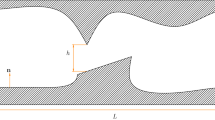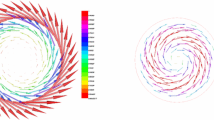Abstract
The friction-type (or called barrier-type) leak interface condition (FLIC) is proposed to model the viscous fluid through a perforated membrane with a threshold permeability, where the flow passes through the perforations only when the stress difference on the membrane is above a threshold. This work establishes a comprehensive study on several numerical approaches for the Stokes/Stokes coupled flow under the FLIC, including the projection, regularization (or called penalty), and domain decomposition methods. In the continuous sense, first, we revisit the well-posedness, introduce the Lagrange multiplier formulation, and show the convergence of the projection method, i.e., the Uzawa algorithm. Second, we approximate the variational inequality by the regularization technique. We derive the approximation error and discuss the applicability of the Picard iteration to the nonlinear regularization problem. And third, a domain decomposition algorithm is proposed to decouple the system into two Stokes problems with the Dirichlet and friction-type leak boundary conditions on \(\Gamma \), respectively. In the discrete sense, we apply the finite element method with P1b/P1-element and enforce the interface condition by mass-lumping technique. We obtain the error estimates of the finite element approximation. The convergence of the discrete version of the projection methods (including the Uzawa and Active/Inactive set algorithms), the regularization problem, and the domain decomposition algorithm are investigated as with the continuous cases. We carry out several numerical experiments to confirm the theoretical results.

















Similar content being viewed by others
References
Almonacid, J.A., Diaz, H.S., Gatica, G.N., Márquez, A.: A fully mixed finite element method for the coupling of the Stokes and Darcy–Forchheimer problems. IMA J. Numer. Anal. 40(2), 1454–1502 (2020)
Angotm, P.: Well-posed Stokes/Brinkman and Stokes/Darcy problems for coupled fluid-porous viscous flows. ESAIM: M2AN 52, 1875–1911 (2018)
Ayadi, M., Cdoura, M.K., Sassi, T.: Mixed formulation for stokes problem with Tresca friction. C. R. Math. Acad. Sci. Paris 348, 1069–1072 (2010)
Beavers, G.S., Joseph, D.D.: Boundary conditions at a naturally permeable wall. J. Fluid Mech. 30, 197–207 (1967)
Brenner, S.C., Scott, L.R.: The Mathematical Theory of Finite Element Methods, 3rd edn. Springer, Berlin (2007)
Burman, E., Hansbo, P.: A unified stabized method for Stokes’s and Darcy’s equations. J. Comput. Appl. Math. 198, 35–51 (2007)
Cao, Y., Gunzburger, M., He, X., Wang, X.: Robin-Robin domain decomposition methods for the steady-state Stokes–Darcy system with the Beavers–Joseph interface condition. Numer. Math. 117, 601–629 (2011)
Conca, C.: Étude d’un fluide traversant une paroi perforeé. I. Comportement limite près de la paroi. J. Math. Pures Appl. 66, 1–43 (1987)
Conca, C.: The Stokes sieve problem. Commun. Appl. Numer. Methods 4, 113–121 (1988)
Connors, J., Howell, J.S., Layton, W.J.: Decoupled time stepping methods for fluid-fluid interaction. SIAM J. Numer. Anal. 50(3), 1297–1319 (2009)
Discacciati, M., Quarteroni, A., Valli, A.: Robin-Robin domain decomposition methods for the Stokes–Darcy coupling. SIAM J. Numer. Anal. 45(3), 1246–1268 (2007)
Fu, G., Lehrenfeld, C.: A strongly conservative hybrid DG/Mixed FEM for the coupling Stokes and Darcy flow. J. Sci. Comput. 77, 1605–1620 (2018)
Fujita, H.: A mathematical analysis of motions of viscous incompressible fluid under leak or slip boundary conditions. Res. Inst. Math. Sci. Kokyuroku 888, 199–216 (1994)
Fujita, H.: Non-stationary stokes flows under leak boundary conditions of friction type. J. Comput. Math. 19(1), 1–18 (2001)
Fujita, H.: A coherent analysis of stokes flows under boundary conditions of friction type. J. Comput. Appl. Math. 149, 56–79 (2002)
Fujita, H.: Remarks on the stokes flow under slip and leak boundary conditions of friction type. In: Galdi, G., Rannacher, R. (eds.) Topics in Mathematical Fluid Mechanics, pp. 73–94 (2002)
Fujita, H., Kawarada, H., Sasamoto, A.: Analytical and numerical approaches to stationary flow problems with leak and slip boundary conditions. Lect. Notes Numer. Appl. Anal. 14, 17–31 (1995)
Gatica, G.N., Oyarzúa, R., Sayas, F.-J.: Analysis of fully-mixed finite element methods for the Stokes–Darcy coupled problem. Math. Comput. 80, 1911–1948 (2011)
Gatica, G.N., Sequeira, F.A.: Analysis of the HDG method for the Stokes–Darcy coupling. Numer. Methods Partial Differ. Equ. 33, 885–917 (2017)
Girault, V., Raviart, O.-A.: Finite Element Methods for Navier–Stokes Equations: Theory and Algorithms. Springer, Berlin (1986)
Glowinski, R.: Numerical Methods for Nonlinear Variational Problems. Springer, Berlin (1984)
Hintermüller, M., Kovtunenko, V.A., Kunish, K.: The primal-dual active set method for a crack problem with non-penetration. IMA J. Appl. Math. 69, 1–26 (2004)
Kashiwabara, T.: Finite element method for Stokes equations under leak boundary condition of friction type. SIAM J. Numer. Anal. 51(4), 2448–2469 (2013)
Kashiwabara, T.: On a finite element approximation of the Stokes equations under a slip boundary condition of the friction type. Jpn. J. Ind. Appl. Math. 30, 227–261 (2013)
Kashiwabara, T.: On a strong solution of the non-stationary Navier-Stokes equations under slip or leak boundary conditions of friction type. J. Differ. Equ. 254(2), 756–778 (2013)
Kawarada, H., Fujita, H., Suito, H.: Wave motion breaking upon the shore. GAKUTO Int. Ser. Math. Sci. Appl. 11, 145–159 (1998)
Kikuchi, N., Oden, J.T.: Contact problems in elasticity: a study of variational inequalities and finite element methods, volume SIAM Studies in Applied Mathematics. Society for Industrial and Applied Mathematics (SIAM), Philadelphia, PA (1988)
Layton, W., Tran, H., Trenchea, C.: Analysis of long time stability and errors of two partitioned methods for uncoupling evolutionary groundwater-surface water flows. SIAM J. Numer. Anal. 51, 248–272 (2013)
Layton, W.J., Schieweck, F., Yotov, I.: Coupling fluid flow with porous media flow. SIAM J. Numer. Anal. 40(6), 2195–2218 (2003)
Li, J., Huang, P., Zhang, C., Guo, G.: A linear, decoupled fractional time-stepping method for the nonlinear fluid–fluid interaction. Numer. Methods Partial Differ. Equ. 35(5), 1873–1889 (2019)
Li, Y., An, R.: Semi-discrete stabilized finite element methods for Navier-Stokes equations with nonlinear slip boundary conditions based on regularization procedure. Numer. Math. 117, 1–36 (2011)
Li, Y., An, R.: Two-level pressure projection finite element methods for Navier–Stokes equations with nonlinear slip boundary conditions. Appl. Numer. Math. 11, 285–297 (2011)
Li, Y., Li, K.: Penalty finite element method for Stokes problem with nonlinear slip boundary conditions. Appl. Math. Comput. 204, 216–226 (2008)
Lions, J.L.: Quelques méthodes de résolution des problèmes aux limites non linéaires. Dunod, Gauthier-Villars, Paris (1969)
Lions, J.L., Temam, R., Wang, S.: Models for the coupled atmosphere and ocean (CAO I). Comput. Mech. Adv. 1, 1–54 (1993)
Lions, J.L., Temam, R., Wang, S.: Mathematical theory for the coupled atmosphere-ocean models (CAO III). J. Math. Pures. Appl. 74, 105–163 (1995)
Mardal, K.A., Tai, X.-C., Winther, R.: A robust finite element method for Darcy–Stokes flow. SIAM J. Numer. Anal. 40, 1605–1631 (2002)
Maris, F., Vernescu, B.: Effective leak conditions across a membrane. Complex Var. Elliptic Equ. 57(2–4), 437–453 (2012)
Márquez, A., Meddahi, S., Sayas, F.-J.: Strong coupling of finite element methods for the Stokes–Darcy problem. IMA J. Numer. Anal. 35, 969–988 (2015)
Ochoa-Tapia, J.A., Whitaker, S.: Momentum transfer at the boundary between a porous medium and a homogeneous fluid I: theoretical development. Int. J. Heat Mass Transf. 38, 2635–2646 (1995)
Rivière, B.: Analysis of a discontinuous finite element method for the coupled Stokes and Darcy problems. J. Sci. Comput. 22, 479–500 (2005)
Rui, H., Zhang, R.: A unified stabilized mixed finite element method for coupling Stokes and Darcy flow. Comput. Methods. Appl. Mech. Eng. 198, 2692–2699 (2009)
Saffman, P.G.: On the boundary condition at the surface of a porous medium. Stud. Appl. Math. L50, 93–101 (1971)
Saito, N.: On the stokes equations with leak and slip boundary conditions of friction type regularity of solutions. Publ. RIMS Kyoto Univ. 40(2), 345–383 (2004)
Song, P., Wang, C., Yotov, I.: Domain decomposition for Stokes–Darcy flows with curved interfaces. Procedia Comput. Sci. 18, 1077–1086 (2013)
Suito, H., Kawarada, H.: Numerical simulation of spilled oil by fictitious domain method. Jpn. J. Ind. Appl. Math. 21, 219–236 (2004)
Thomée, V.: Galerkin Finite Element Methods for Parabolic Problems. Springer, Berlin (1984)
Zhang, Y., Hou, Y., Shan, L.: Stability and convergence analysis of a decoupled algorithm for a fluid–fluid interaction problem. SIAM J. Numer. Anal. 54(5), 2833–2867 (2016)
Zhang, Y., Zheng, H., Hou, Y., Shan, L.: Optimal error estimates of both coupled and two-grid decoupled methods for a mixed Stokes–Stokes model. Appl. Numer. Math. 133, 116–129 (2018)
Zhou, G., Kashiwabara, T., Oikawa, I., Chung, E., Shiue, M.-C.: An analysis on the penalty and Nitsche’s methods for the Stokes–Darcy system with a curved interface. Appl. Numer. Math. 165, 83–118 (2021)
Author information
Authors and Affiliations
Corresponding author
Additional information
Publisher's Note
Springer Nature remains neutral with regard to jurisdictional claims in published maps and institutional affiliations.
The research of Guanyu Zhou was supported by the National Natural Science Foundation of China (No. 12171071 and No. 12071061) and the Central Guidance on Local Science and Technology Development Fund of Sichuan Province (2021ZYD0002). The research of Feifei Jing is supported by the National Natural Science Foundation of China (No. 12001413 and No. 12171415) and the Postdoctoral Science Foundation of China (No. 2021M692647). The research of Takahito Kashiwabara was supported by JSPS Grant-in-Aid for Early-Career Scientists (No. 20K14357).
Rights and permissions
Springer Nature or its licensor (e.g. a society or other partner) holds exclusive rights to this article under a publishing agreement with the author(s) or other rightsholder(s); author self-archiving of the accepted manuscript version of this article is solely governed by the terms of such publishing agreement and applicable law.
About this article
Cite this article
Zhou, G., Jing, F. & Kashiwabara, T. The numerical methods for the coupled fluid flow under the leak interface condition of the friction-type. Numer. Math. 153, 729–773 (2023). https://doi.org/10.1007/s00211-023-01348-w
Received:
Revised:
Accepted:
Published:
Issue Date:
DOI: https://doi.org/10.1007/s00211-023-01348-w




